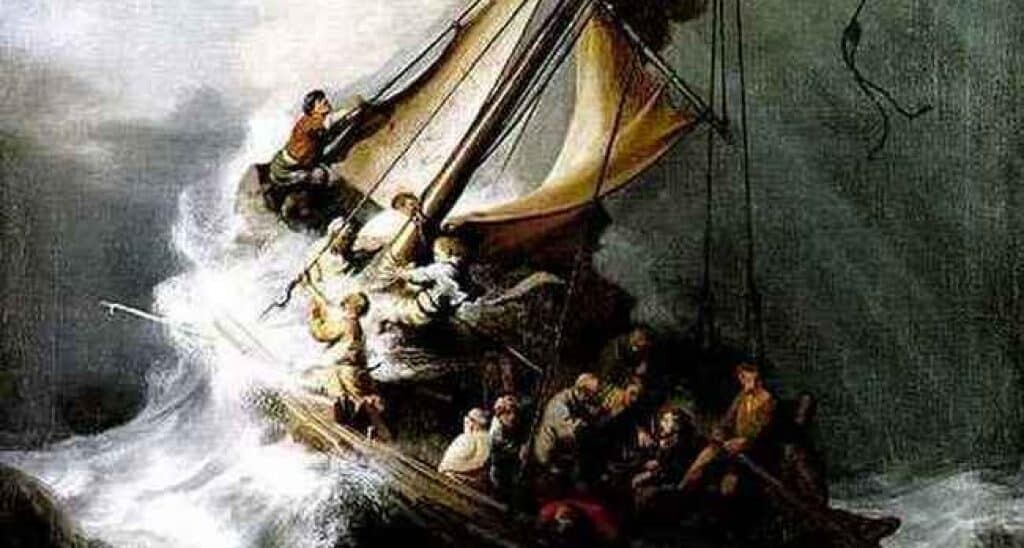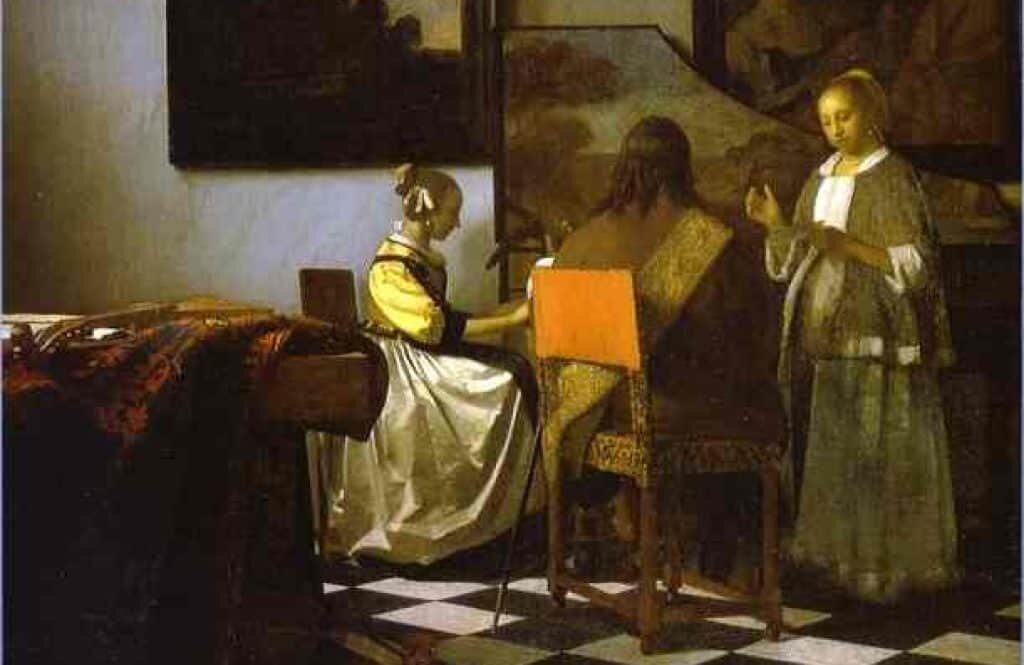Built in Boston at the turn of the century by the late Mrs. Jack Gardner, the Italianate mansion was used to house her private collection of art and share it with the public. Unfortunately, as the festivities of St. Patrick’s Day came to an end on March 18, 1990, two unknown thieves rob the Isabella Stewart Gardner Museum and walked away with a dazzling collection of art masterpieces by Rembrandt and Vermeer valued to be as high as at $500 million today, making it the largest art theft in history.
After 20 years and $20 million spent investigating the Isabella Gardner Museum heist, there’s never been a single arrest, and “The Gardner Heist” remains one of the nation’s most extraordinary unsolved mysteries.
Like a scene from a Hollywood movie, two men, dressed as Boston police officers, buzz the museum’s service entrance and tell the desk guard they were responding to a report of a disturbance and needed to investigate. The young, inexperienced guard, going against company protocol buzzed them in at 1:24 a.m.
At that moment, the “perfect crime” began to take place.
Upon gaining access to the museum, the two security guards on duty were quickly overpowered, bound with duct tape, and handcuffed in separate remote areas in the basement. Other than the security guards, the only other security system the museum had in place was an internal one. A “panic” button was located behind the security desk and since it had not been activated, the police had no knowledge that a robbery was in progress.

The Storm on Sea of Galilee was stolen in Gardner Museum Heist, by Rembrandt
For the next 81 minutes, the thieves basically had the “run of the house.”
Records show that their steps were traced by the museum’s motion detector system which showed that the thieves went immediately to the second floor, and then split up. One headed into the Dutch Room at the south end of the building and the other to the Short Gallery, a room located above the museum’s main entrance. The thieves showed little regard to care for the valuable items they were stealing. They smashed frames, ripped out the artwork, and left broken glass and remnants of canvas behind.
Taken in the Isabella Gardner Museum heist were 13 valuable masterworks, including two principal works –the only seascape that Rembrandt is known to have painted, ’The Sea of Galilee,” and “The Concert,” by Vermeer, one of only about 35 known paintings by the Dutch artist, would command at least $50 million dollars each on the open market today.
According to the FBI Art Theft Program website, the following works of art were taken:
Dutch Room Gallery
VERMEER, THE CONCERT; Oil on canvas, 72.5 x 64.7 cm.
REMBRANDT, A LADY AND GENTLEMAN IN BLACK; Oil on canvas, 131.6 x 109 cm. Inscribed at the foot, REMBRANDT. FT: 1633.
REMBRANDT, THE STORM ON THE SEA OF GALILEE, Oil on canvas, 161.7 x 129.8. cm. Inscribed on the rudder, REMBRANDT. FT: 1633
REMBRANDT, SELF PORTRAIT, Etching, 1 3/4″ x 2″, (Postage Stamp size)
GOVAERT FLINCK, LANDSCAPE WITH AN OBELISK , Oil on an oak panel, 54.5 x 71 cm. Inscribed faintly at the foot on the right; R. 16.8 (until recently this was attributed to Rembrandt).
CHINESE BRONZE BEAKER OR “KU”, Chinese, SHANG DYNASTY, 1200-1100 BC; height of 10 “, diameter of 6 1/8″, with a weight of 2 pounds, 7 ounces.
Short Gallery
DEGAS, LA SORTIE DU PELAGE, pencil and watercolor on paper, 10 x 16 cm.
DEGAS, CORTEGE AUX ENVIRONS DE FLORENCE, pencil and wash on paper, 16 x 21 cm. (This and the above were originally in a single frame.)
DEGAS, THREE MOUNTED JOCKEYS; Black ink, white, flesh and rose washes, probably oil pigments, applied with a brush on medium brown paper, 30.5 x 24 cm.
DEGAS, PROGRAM FOR AN ARTISTIC SOIREE; Charcoal on white paper, 24.1 x 30.9 cm.
DEGAS, PROGRAM FOR AN ARTISTIC SOIREE; a less finished version of the above, charcoal on buff paper, 23.4 x 30 cm. (This and the above were originally in a single frame.)
Blue Room Gallery
MANET, CHEZ TORTONI; Oil on canvas, 26 x 34 cm
Despite a $5 million dollar reward, neither the robbers nor any of the stolen works of art have ever surfaced, and even if it did, prosecution of the persons responsible for the crime would not be possible as the statute of limitations ran out in the mid-1990s. A fact that frustrates law enforcement gives hope to museum officials as this may increase the chances of the artwork showing up or being returned. Museum officials take heart at the fact that some masterworks stolen from museums have surfaced after many years.
More details have emerged about the many leads pursued by investigators including an eye witness who saw the thieves just before they entered the museum and an offer to return the paintings in 1994 that was never publicized.
Marking the 20th anniversary of the Isabella Gardner Museum heist, the FBI began running a poster on digital billboards announcing the $5 million dollars in reward for the stolen art. According to Gail Marcinkiewicz, a spokeswoman for the FBI in Boston said Clear Channel Outdoor began running an FBI poster on two of its digital billboards, announcing the $5 million reward for the stolen art and urging anyone with information to contact the FBI and go to www.gardnermuseum.org for more information. The billboards are on I-93 in Stoneham and I-495 in Lawrence, she said.
Federal authorities are now offering immunity from prosecution and promising confidentiality in exchange for the artwork.
In a more recent development, in an article published in The Boston Globe on April 4, 2010, “Turf War May Have Ruined Gardner Heist Lead,” ex FBI special agent Robert K. Wittman says he believed from French wiretaps and his covert dealings with the two French intermediaries that the Corsican mob did have control of the stolen artwork. A special agent for 20 years, Wittman established the FBI’s Art Theft unit and is credited with recoveries of hundreds of millions of dollars of art and antiquities during his career, many of which he recounts in his book, “Priceless: How I Went Undercover to Rescue the World’s Stolen Treasures,” along with his experiences of the Gardner case.
Wittman, who posed undercover in 2006 and 2007 as a wealthy art collector interested in purchasing several of the paintings through two Frenchmen who had alleged ties to the Corsican mobsters. The French intermediaries said they could deliver the stolen Vermeer, valued at more than $100 million, and at least one of the two large Rembrandts that were taken. If true, the disclosures provide the first real clues as to what happened to the 11 paintings and drawings, plus an ancient Chinese vase and a finial, stolen out of the Gardner Museum on March 18, 1990.
The FBI was on the trail of recovering the principal masterpieces stolen from the Isabella Stewart Gardner Museum from a criminal gang in Corsica two years ago only to have its efforts dashed, in part because of bureaucratic infighting among federal agents and supervisors.

The Concert by Dutch painter Johannes Vermeer.
According to the article in “The Boston Globe,” Wittman contends that the lead he worked on beginning in late 2006 — which he describes as the first credible tip received by the FBI — was sabotaged by the reluctance of FBI officials to overrule the FBI supervisory agent on the Gardner investigation who refused to allow Wittman to make his own decisions on the Corsican case.
Instead, the supervisor, who is only identified in the book as “Fred,’’ micromanaged Wittman’s interactions with the two French intermediaries even though he was unfamiliar with overseeing an undercover operation. At one point, Wittman writes, Fred tried to get Wittman thrown off the case by sending an official memorandum to FBI chiefs in Washington questioning whether Wittman was trying to delay completing the investigation until retiring so he could win the $5 million reward as a private citizen.
In addition, Wittman writes, Fred — who had never before traveled to a foreign country on official business — was quick to offend his counterparts in French law enforcement on the investigation, seeking to assert the FBI’s control of the case even though many of the dealings were to take place inside France.
Despite his pleas, Wittman writes, FBI officials refused to wrest control of the investigation from Fred because of the historic reluctance of those at FBI headquarters to overrule the decisions of the agency’s local supervisors. French authorities also weakened the thrust of the investigation by mandating that a French intelligence officer work undercover with Wittman and by refusing at one key point to allow one of the two intermediaries to enter France for a meeting because he was a fugitive wanted in France on another crime.
“Bureaucracies and turf fighting on both sides of the Atlantic had destroyed the best chance in a decade to rescue the Gardner paintings,’’ Wittman writes. “We’d blown an opportunity to infiltrate a major art crime ring in France, a loose network of mobsters holding as many as 70 stolen masterpieces.’’
Related: Theft of the Mona Lisa Made Her Famous
Despite his criticisms of the investigation, the key question that emerges from Wittman’s book is whether the lead was a legitimate one. Did the French intermediaries — a fugitive accountant named Laurenz Cogniat and his associate, identified only as Sunny — have real ties with Corsican mobsters, and did those mobsters have control of the paintings? Or was the pair just trying to pull a scam on Wittman, who had told them that he was able to put up millions to buy the Gardner paintings?
Wittman says he believed he was on track to recover the Gardner paintings after French police told him that they had spotted Sunny meeting with Corsican mobsters in Marseilles and Sunny had been heard on wiretaps speaking of “frames for Bob.’’ Wittman’s undercover name was Bob Clay.
But while the three met repeatedly over a two-year period in France, Spain, and in the United States, Wittman had trouble focusing the intermediaries’ attention on closing the deal for the Gardner paintings. Wittman dropped out of the case in early 2008 when Sunny approached him to see whether he was interested in buying four paintings that had just been stolen from a museum in Nice. Wittman turned the lead over to another FBI undercover agent. Sunny was subsequently arrested in the deal, ending Wittman’s hopes of using him as a conduit for recovering the Gardner paintings.
Wittman ends his book recounting a wistful conversation he had with Pierre Tabel, then the chief of France’s National Art Crime Squad, about their efforts over the previous two years to recover the Gardner paintings.
“Pierre,’’ Wittman asks him, “Do you think we had a chance? For the paintings?’’
“Absolutement,’’ Tabel responded. “We have a good idea who has them. We know to whom Sunny was speaking. But now that we arrest Sunny . . . the case is gone. We will not have this chance again for many years.’’
Top image: Top image: The empty frames of two stolen Rembrandt paintings from the Isabella Stewart Gardner Museum. Source: Chris Dignes / CC by SA 1.0.